Posted by rootandbranch
Editor’s note: This blog is from the perspective of five University of Pittsburgh students — Kirsten, Steve, Darcie, Erin, and Sara — who completed a class this summer called “Digital Marketing Search Fundamentals”, taught by Zack Duncan of Root and Branch.
Introduction
Our digital marketing class this summer did not give us credits that count towards graduation (in fact, some of us graduated in Spring 2020), nor did it give us a grade. Instead, we learned about paid search and organic search along with some of the key concepts central to digital marketing. We also became certified in Google Ads Search along the way.
We each had different reasons for taking the course, but we all believe that digital marketing will have value for us in our lives.
At the beginning of the term, in June 2020, we were asked, “What is one thing you’re hoping to get out of this class?” Here are some of our responses to that question:
- I hope to gain a strong understanding of SEO and Google Ads, and to get hands-on experience to understand how both would be used in a work setting.
- I want to learn something about marketing that I might not learn in the classroom.
- I'm hoping to become more competitive in this difficult job market.
- I hope to build on my resume and develop skills for personal use.
- I want to learn a foundational skill that can be applied in many different aspects of business.
Now that we’ve completed the class, we wanted to share our thoughts on why we believe digital marketing matters — both for our lives today and as we look ahead to the future. We’re also going to cover five of the most important building blocks we learned this summer, that have helped us see how all the pieces of digital marketing fit together.
Part 1: Why digital marketing matters
Why digital marketing training matters now
To become more competitive candidates in applying for jobs
Some of us are recent grads in the midst of searching for our first jobs after college. Some of us are still in school and are actively looking for internships. We’ve all seen our fair share of job listings for positions like “Digital Marketing Intern” or “Digital Marketing Associate”. Given that the majority of us are marketing majors, you might think it’s safe to assume we would be qualified for at least an interview for those positions.
Nope.
Before gaining a solid foundation in digital marketing, we were often quite limited in the listings we were qualified for. But things have been changing now that we can say we’re certified in Google Ads Search and can speak to topics like digital analytics, SEO, and the importance of understanding the marketing funnel.
To help with growing freelance side businesses
Towards the beginning of the pandemic, a few of us were dangerously close to graduation with little to no hope of finding a job in marketing. Instead of binge-watching Netflix all day and hoping some fantastic opportunity would magically come our way, the entrepreneurial among us decided to see how we could use our current skills to generate revenue.
One of us is especially interested in graphic design and learned everything there was to know in Adobe Creative Suite to become a freelance graphic designer, starting a side business in graphic design, and designs logos, labels, menus, and more.
After this class, finding clients has changed in a big way now. Instead of being limited to looking for clients in social media groups, digital marketing knowledge opens up a whole new world. With a functioning website and a knowledge of both paid and organic search, the process of finding new customers has dramatically changed (for the better!).
To be more informed consumers
While a digital marketing background doesn’t instantly translate to job opportunities for everyone, it can help all of us become more informed consumers.
As consumers, we want to pay for quality goods and services at a fair price. Some basic digital marketing knowledge gives us a better understanding of why the search engine results page (SERP) findings show up in the order that they do. Knowing about keywords, domain authority (for organic search) and quality scores (for paid results) can demystify things. And that’s just on the SERP.
Moving off the SERP, it’s helpful to know how nearly every advertisement we see is somehow targeted to us. If you are seeing an ad, there is a very good chance you fall into an audience segment that a brand has identified as a potential target. You may also be seeing the ad due to a prior visit to the brand’s website and are now in a retargeting audience (feel free to clear out those cookies if you’re sick of them!).
The more information you have as a consumer, the more likely you are to make a better purchase. These few examples just go to show how digital marketing training matters now, even if you are not the one actively doing the digital marketing.
How a digital marketing foundation be useful in the future
It’s helpful in creating and growing a personal brand
Your brand only matters if people know about it. You could sit in your room and put together the most awesome portfolio website for yourself and create a solid brand identity, but if no one else knows about it, what’s the point? Digital marketing concepts like understanding SEO basics can help make your presence known to potential customers, employers, and clients.
It would be terrible if your competition got all the business just because you didn’t use the simple digital marketing tools available to you, right? Digital marketing efforts can have many different goals ranging from making sales to just increasing general awareness of your brand, so get out there and start!
To become a more flexible contributor in future career opportunities
One thing we’ve heard consistently in the job search process is employers love flexible, cross functional employees. It seems the most successful and valued employees are often those that are not only experts in their field, but also have a pretty good understanding of other subjects that impact their work. Let’s say you’re an account manager for a digital agency, and you have some great insight that you think could be helpful in driving some new ad copy testing for your biggest client. It’s going to be a whole lot easier talking with your copywriter and media team (and being taken seriously by them), if you have an understanding of how the text ads are built.
To see data as an opportunity for action, as opposed to just numbers
Are you someone who enjoys numbers and performance metrics? That's great! So are we! But those numbers are meaningless without a digital marketing background to provide context for the data.
Understanding data is a valuable tool for getting to know your audience and evaluating advertising campaigns. Seeing that your Google Search text ad has a poor click-through rate is only actionable if you have the foundation to take steps and improve it. Analyzing your website’s metrics and finding that you have a low average session duration is meaningless if you don’t connect the dots between the numbers and what they mean for your web design or your on-page content.
It’s pretty clear that the numbers don’t give much value to a marketer or a business without the ability to recognize what those metrics mean and the actions that can be taken to fix them. As we advance in our careers and have more and more responsibility for decision making, digital marketing fundamentals can continue to grow our experience with turning data into insight-driven action.
To optimize for conversions — always
Whatever the goal, it’s important to know if you’re operating efficiently in terms of your conversions. In other words, you need to know if you’re getting a return for the investment (time, money, or both) you’re putting in. When you’re operating to get the most conversions for the lowest cost, you are employing a mindset that will help your marketing efforts perform as well as they can.
Having a digital marketing foundation will allow you to think intelligently about “conversions”, or the kinds of results that you’d like to see your marketing efforts generate. A conversion might be a completed sale for an e-commerce company, a submitted lead form for a B2B software company, or a new subscriber for an online publication.
Whatever the desired conversion action, thinking about them as the goal helps to give context in understanding how different marketing efforts are performing. Is your ad performing well and should it receive more media spend, or is it just wasting money?
Thinking about conversions isn’t always easy, and may take some trial and error, but it can lead to making smart, measurable, and cost-effective decisions. And those decisions can get smarter over time as we get more and more familiar with the five key building blocks of digital marketing (at least the five that we’ve found to be instructive).
Part 2: Understanding five building blocks of digital marketing
1. The marketing funnel (customer journey)
The marketing funnel (or the user/customer journey) refers to the process by which a prospective customer hears about a product or service, becomes educated about the product or service, and makes a decision whether or not to purchase the product or service in question.
It encompasses everything from the first time that brand awareness is established to the potential purchase made by the customer. The awareness stage can be known as the “top of the funnel”, and there are lots of potential prospects in that audience.
From there, some prospects “move down the funnel” as they learn more and get educated about the product or service. Those that don’t move down the funnel and progress in their journey are said to “fall out” of the funnel.
As the journey continues, prospects move closer to becoming customers. Those who eventually “convert” are those that completed the journey through the bottom of the funnel.
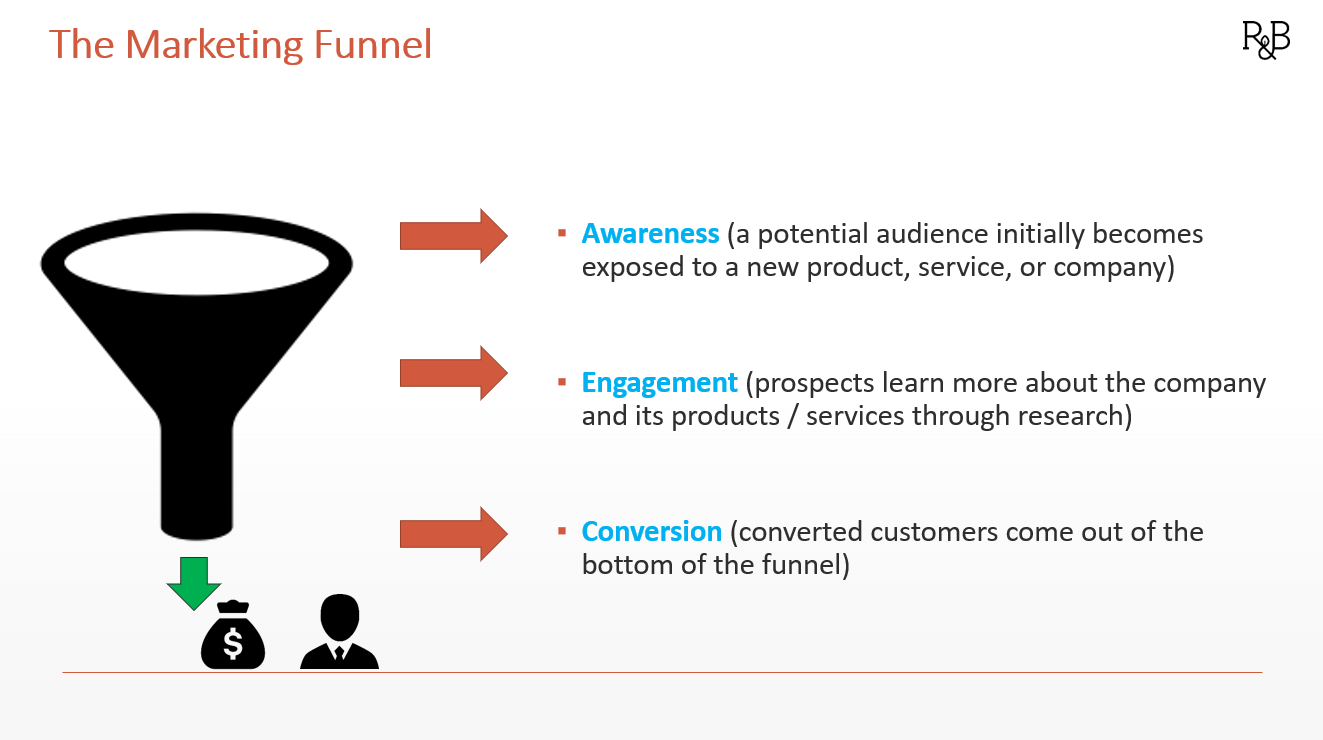
Understanding that there is such a thing as a customer journey has helped to frame our thinking for different types of marketing challenges. It essentially boils down to understanding where, why, when, and how your prospects are engaging with your brand, and what information they will need along the way to conversion.
2. Paid search vs. organic search and the SERP
For many of us, one of the first steps in understanding paid vs. organic search was getting a handle on the SERP.
The slide below is our “SERP Landscape” slide from class. It shows what’s coming from paid (Google Ads), and what’s coming from organic search. In this case, organic results are both local SEO results from Google My Business, and also the on-page SEO results. Here’s a link to a 92-second video with the same content from class.
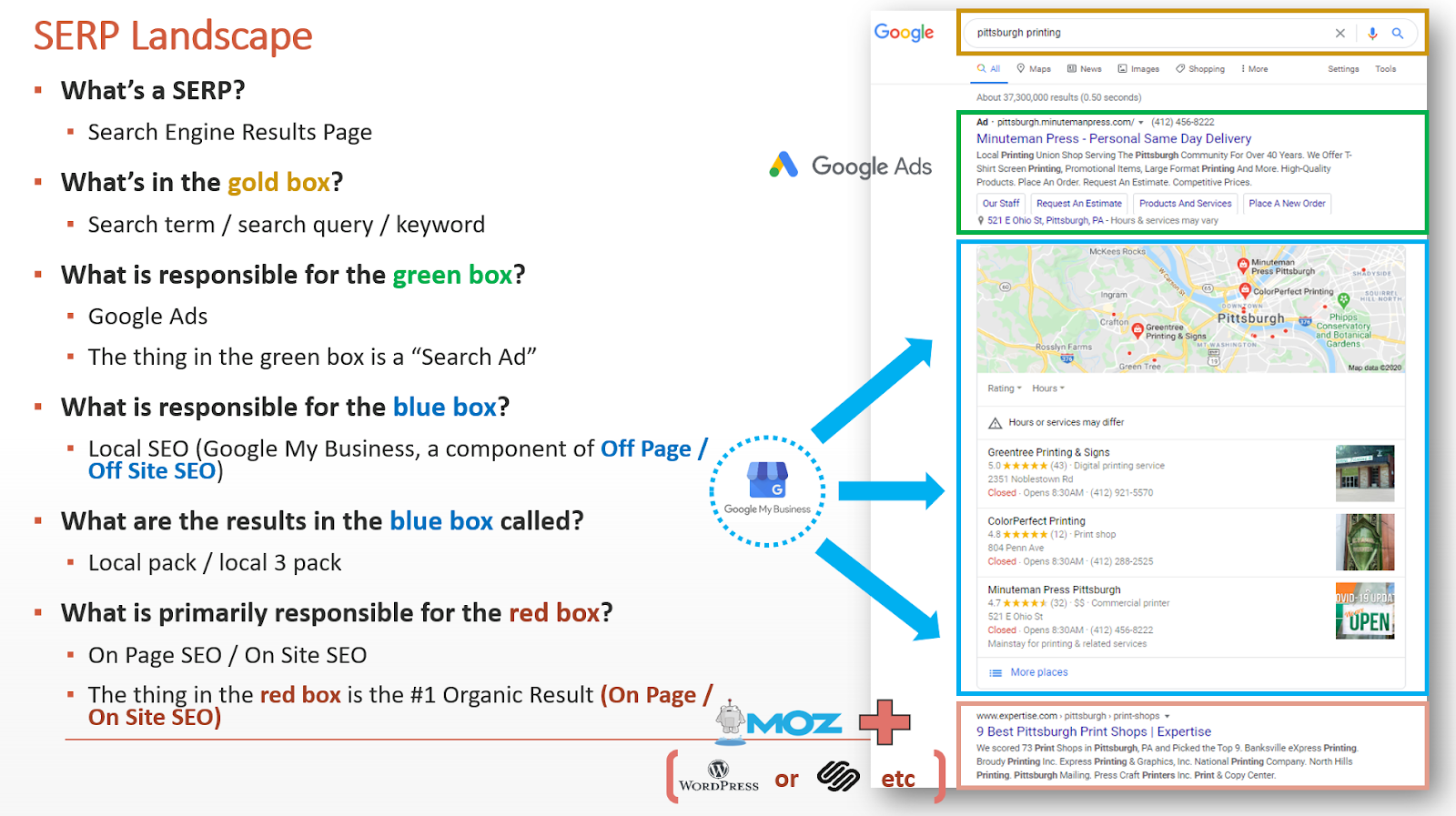
We learned to look for the little “Ad” designation next to the paid text ads that are often at the top of the SERP.
These are search results with the highest AdRank who are likely willing to bid the most on the specific keyword in question. Since paid search is based on CPC (cost per click) pricing, we learned that the advertiser doesn’t incur any costs for their ad to show up, but does pay every single time the ad is clicked.
Although many CPCs might range in the $2 – $3 range, some are $10 and up. With that kind of investment for each click, advertisers really need to focus on having great landing pages with helpful content that will help drive conversions.
Organic search, on the other hand, is “free” for each click. But it also relies on great content, perhaps even more so than paid search. That’s because the only way to get to the top of the organic search rankings is to earn it. There’s no paying here!
Search engines like Google are looking for Expertise, Authoritativeness, and Trustworthiness (E-A-T) in content to rank highly on the SERP. In addition to making good local sense for Google, it all comes back to the core of Alphabet’s business model, as the slide below shows.
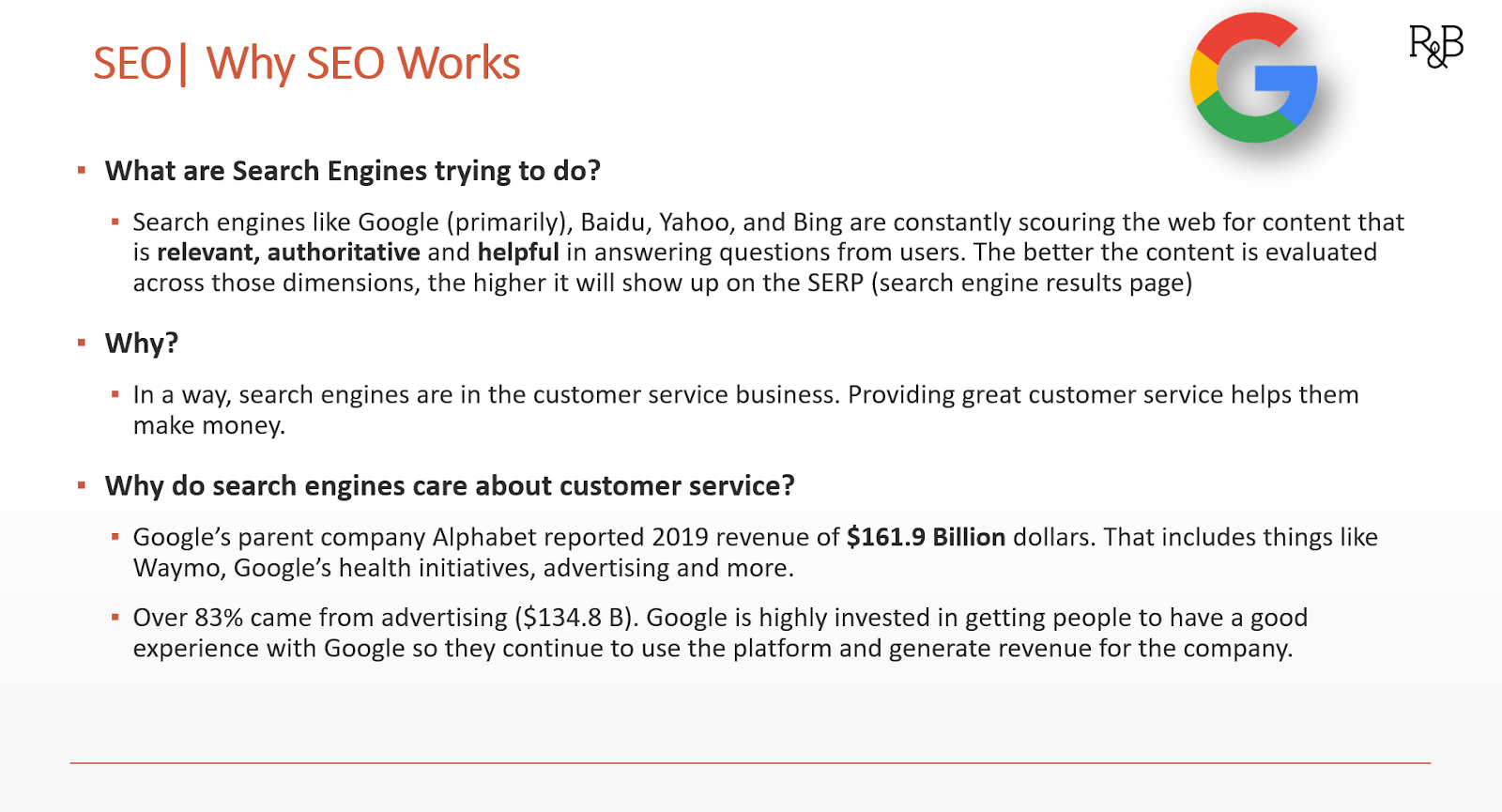
Understanding Google’s motivations help us understand what drives organic search and the SERP landscape overall. And understanding the basics of paid and organic search is an important foundation for all aspiring digital marketers who want to work in the field.
3. Inbound vs. outbound marketing
Are you working to push a message out to an audience that you hope is interested in your product or service? If so, you’re doing some outbound marketing, whether it be traditional media like billboards, television, or magazines, or even certain types of digital advertising like digital banner ads. Think about it as a giant megaphone broadcasting a message.
Inbound work, on the other hand, aims to attract potential customers who are actively engaged in seeking out a product or service. Search marketing (both paid search and organic search) are perfect examples of inbound, as they reach prospects at the moment they’re doing their research. Instead of a megaphone, think of a magnet. The content that does the best job in solving problems and answering questions will be the content with the strongest magnetic pull that gets to the top of SERPs and converts.
If you’re going to be here for a while, click the image below for more information on how we think about content in the context of digital marketing efforts.
4. Basic digital marketing metrics
There are some universal metrics that we all need to understand if we’re going to develop a competency in digital marketing. Click through rate (CTR), for example, is a great way to measure how effective an ad unit or organic result is in terms of generating a click.
But before we can fully understand CTR (clicks divided by impressions), we first need to make sure we understand the component parts of the metric. Here are four of those key components that we learned about during our digital marketing training:
- Impression: A search result (paid or organic) or an ad shows up on a page
- Click: A user clicking the search result or ad on a page triggers a recorded click
- Conversion: After clicking on the search result or ad, the user completes an action that is meaningful for the business. Different types of businesses have different conversion actions that are important to them.
- Cost: While organic search results are “free” (not counting costs associated with creating content), paid ads incur a cost. Understanding the cost of any paid advertising is a crucial component of understanding performance.
How does it all work in practice? Glad you asked! Check out the example below for a hypothetical advertising campaign that served 10,000 impressions, drove 575 clicks, cost $1,000, and generated 20 conversions:
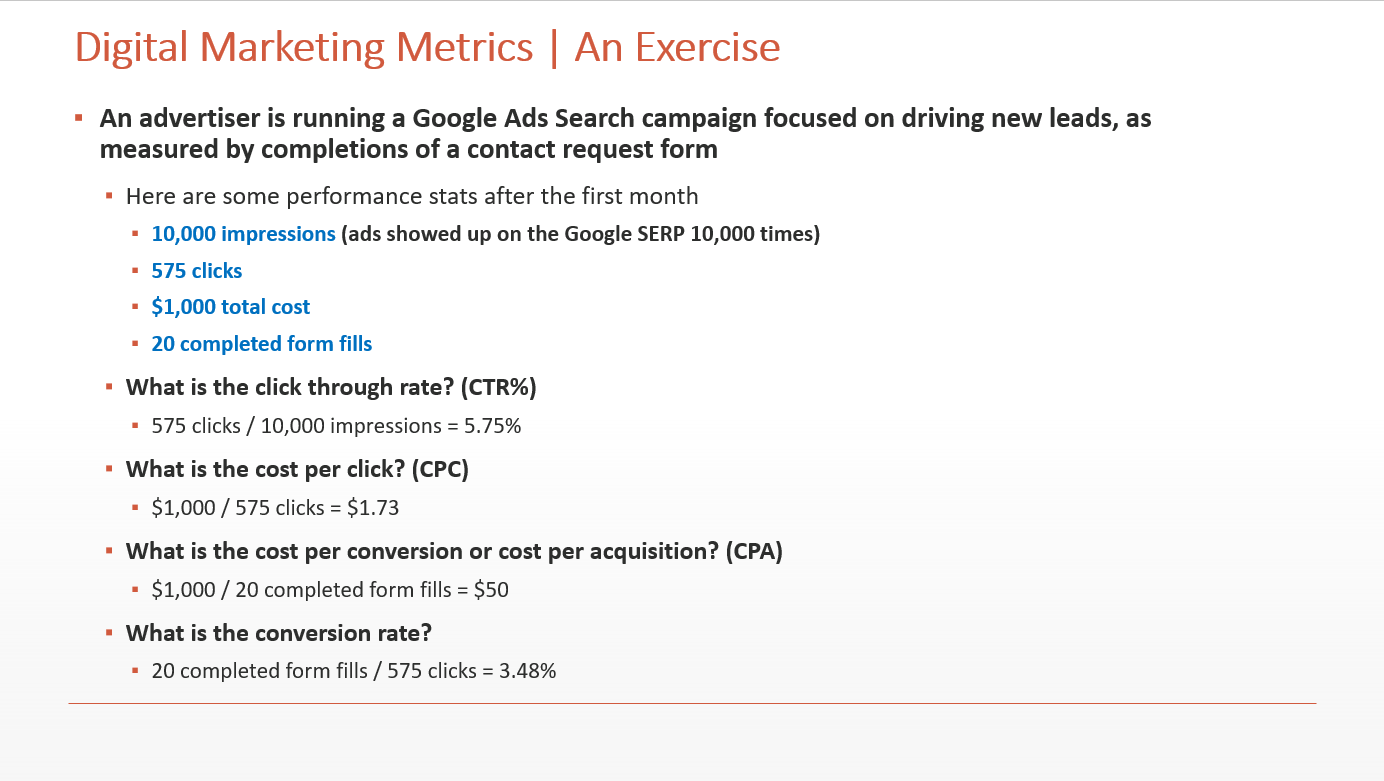
5. Platforms and tools a beginner digital marketer should use
Our class was focused on search marketing, and we talked about one platform for paid and one platform for organic.
On the paid side, there is only one name in the game: Google Ads. Google has free training modules and certifications available through a platform called Skillshop. You’ll need a Google-affiliated email address to log in. After doing so, just search for “Google Ads Search” and you can go through the training modules shown below.
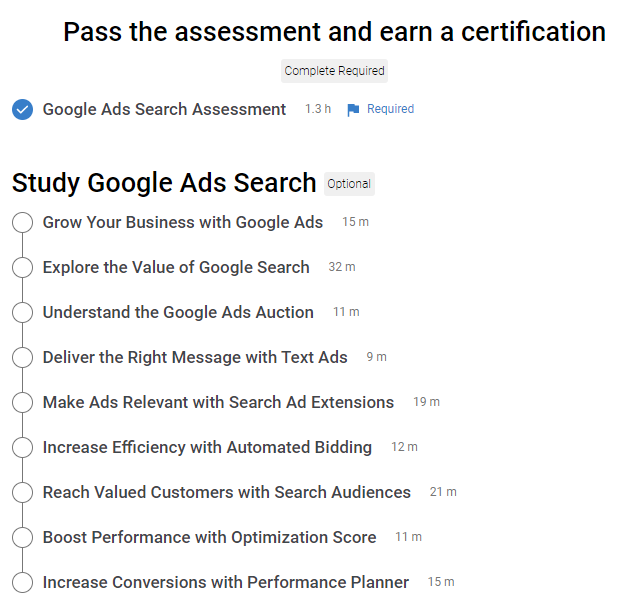
If you’re already a Google Ads pro, you can hop right to the exam and take the timed Google Ads Search Assessment. If you can get an 80% or higher on the 50-question exam, you’ll get a certification badge!
For organic search, we learned about keyword research, title tags, H1s and H2s, anchor text in links, and more through the training available on Moz Academy. The 73-minute Page Optimization course has eight different training sections and includes an On Page Optimization Quiz at the end. Fair warning, some of the content might be worth watching a few times if you’re new to SEO. For most of us this was our first exposure to SEO, and it took some time for most of our brains to sort through the difference between a title tag and an H1 tag!
Another platform that we liked was Google Trends, which can be useful for both paid and organic search, and is just generally a cool way to see trends happening!
There are many more resources and tools out there in the world. Some of us are aiming to get more comfortable with these fundamentals, while some others have already branched out into other disciplines like social media.
Conclusion
Thanks for coming along with us on this digital marketing journey. We hope it was a useful read!
During the process of putting this together, things have changed for us:
- Kirsten landed a full-time job.
- Steve started doing consulting work for a growing Shopify site in Google Ads and Google Analytics, and is planning to make consulting his full-time work.
- Darcie landed a job as a Paid Search Analyst for a national retailer.
For all of us, we know we’re only taking the first steps of our digital marketing futures, and we’re excited to see what the future holds!
Sign up for The Moz Top 10, a semimonthly mailer updating you on the top ten hottest pieces of SEO news, tips, and rad links uncovered by the Moz team. Think of it as your exclusive digest of stuff you don't have time to hunt down but want to read!
![]()

Recent Comments